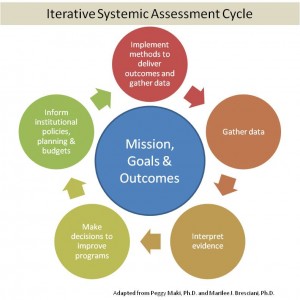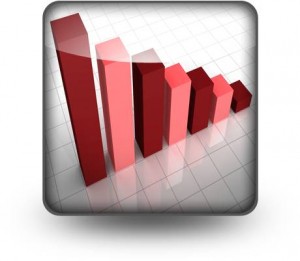 What is a learning goal?
What is a learning goal?
The first step of assessment is to state your learning goals, that is, what you expect students to know, be able to do, or value as a result of their activity. It’s easier to assess knowledge and skills than it is to assess values, but that doesn’t mean you shouldn’t have more ephemeral goals.
When writing goals, think in terms of what students will know and do, not what you will teach or provide. Consider the developmental level of the students. Will they have a basic knowledge or mastery of a certain area or skill? In what ways will you check student learning along the way and give them feedback?
Some disciplines have national standards which can help shape local program goals. The goals need to reflect both good practices in the field as well as the particular approach of Lafayette College.
What are the characteristics of a good assessment plan?
Although assessment methods vary across disciplines, there are some steps that apply regardless of the context:
- setting learning goals
- finding out what you already know about student learning in your program
- gathering multiple kinds of evidence to answer questions you have about students’ progress in learning,
- analyzing and interpreting the findings
- using the findings to celebrate strengths
- using the findings to inform changes such as
- making adjustments to your curriculum or program
- changing teaching/learning methodologies
- re-directing use of resources, including budget allocations.
Good assessment practices are manageable, meaningful, and integrated into daily teaching and learning practices. In many ways, assessment is analogous to a research project, where the object of study is student learning. The methods vary according to one’s discipline; the kinds of evidence used need to make sense with one’s field.
What are the differences between direct and indirect assessment methods?
Direct methods examine actual student performance to determine what students learned and the extent to which students have met the learning goals you established. Example: written assignments, performances, presentations, observations of the quality of field work (e.g., clinical, field experience, internships), written or oral reflection on the link between theory and practice, research and capstone projects, exams, standardized tests, licensure exams, and even student publications.
Indirect methods examine the perspectives of various stakeholders on teaching and learning in order to glean insights on the learning process (the how and why). Examples: student self-appraisals of learning, satisfaction surveys, peer review by faculty, focus groups (e.g., with students, alumni, community partners, employers of graduates).
Both kinds of methods focus on student learning, and both can draw on qualitative and/or quantitative methodology.
Assessment Terminology
Assessment terms are used in a wide variety of ways. We suggest that you use terms that are meaningful to the faculty and students within your discipline. If your discipline doesn’t have established terminology, then a helpful rule of thumb is to use learning goal for broad, overall expectations for student learning, and learning objective for more specific, subsets of student learning.
Many in US higher education use evaluation to encompass the larger picture of examining effectiveness, and assessment to look at student learning. Because this usage varies greatly, at Lafayette we try to use the words “student-learning assessment” in combination so that we are clear.
Student-learning assessment is a part of overall program evaluation or review. It focuses directly on the extent to which students are learning, and those features of the curriculum that promote or hinder learning. Program evaluation encompasses much more, including the overall quality of student experience, budget, quality of facilities, qualifications of faculty, library resources, and so on.
Formative evaluation uses findings about student learning or programs as feedback along the way so that students and programs can celebrate achievements and make improvements as needed. The focus is on the process and progress, and sometimes this is called “informal” assessment.
Summative evaluation characterizes the use of assessment or evaluation findings to make decisions that are high stakes, such as course grades, promotion and tenure, and retention or elimination of programs. The focus is on the sum or final product of student work or a program’s impact.
Who is responsible for conducting assessment?
The faculty members of each particular department or program are responsible for articulating overall learning goals, choosing methods for assessing students’ progress toward these goals, and using the findings to celebrate strengths and improve their programs. These assessment practices take place within the larger context of the Colege’s mission.
How should assessment results be used?
 The primary purposes of assessment are to guide student learning, and to inform and improve teaching and curriculum. Both formal and informal assessment can reveal student learning in relation to teacher effectiveness, student work, classroom assignments, etc. Assessment results may reveal particular strengths or weaknesses within a given curriculum. Care should be taken in analyzing and interpreting findings, so as to distinguish between causal and correlative factors.
The primary purposes of assessment are to guide student learning, and to inform and improve teaching and curriculum. Both formal and informal assessment can reveal student learning in relation to teacher effectiveness, student work, classroom assignments, etc. Assessment results may reveal particular strengths or weaknesses within a given curriculum. Care should be taken in analyzing and interpreting findings, so as to distinguish between causal and correlative factors.
There are many factors in student performance in addition to quality of teaching and curriculum, including motivation, prior knowledge and need for learning support. That said, it is safe to make a link between your curriculum and students leaving your program with strong knowledge and skills. And in those cases where students as a whole don’t meet your program’s standards, it is helpful to examine your curriculum, teaching and learning practices, and the need for additional or modified student preparation.